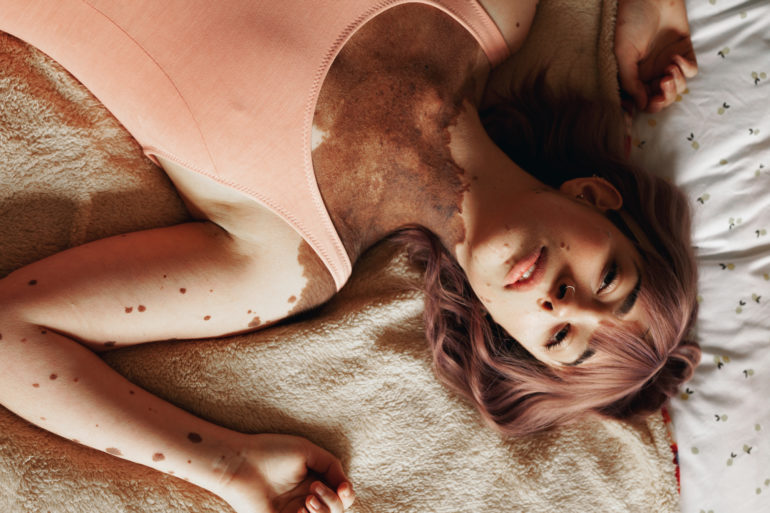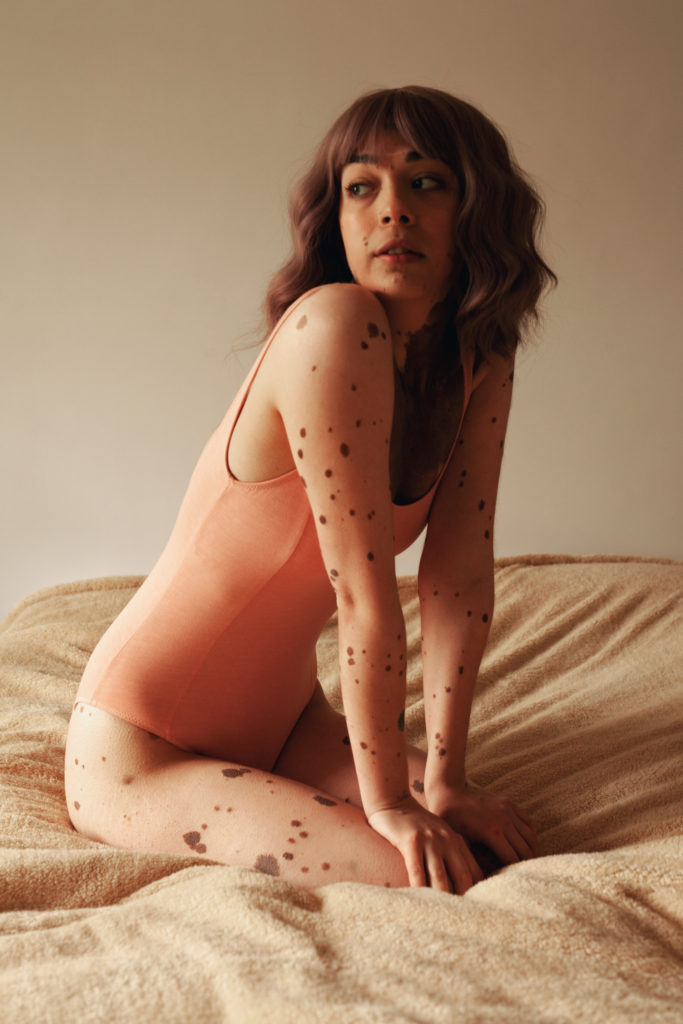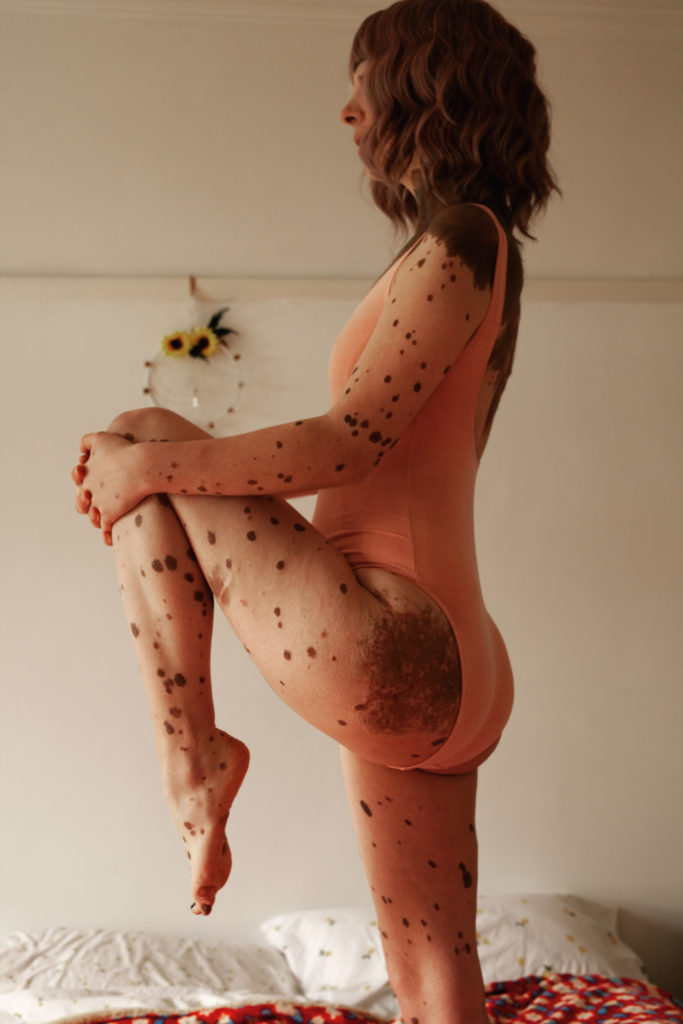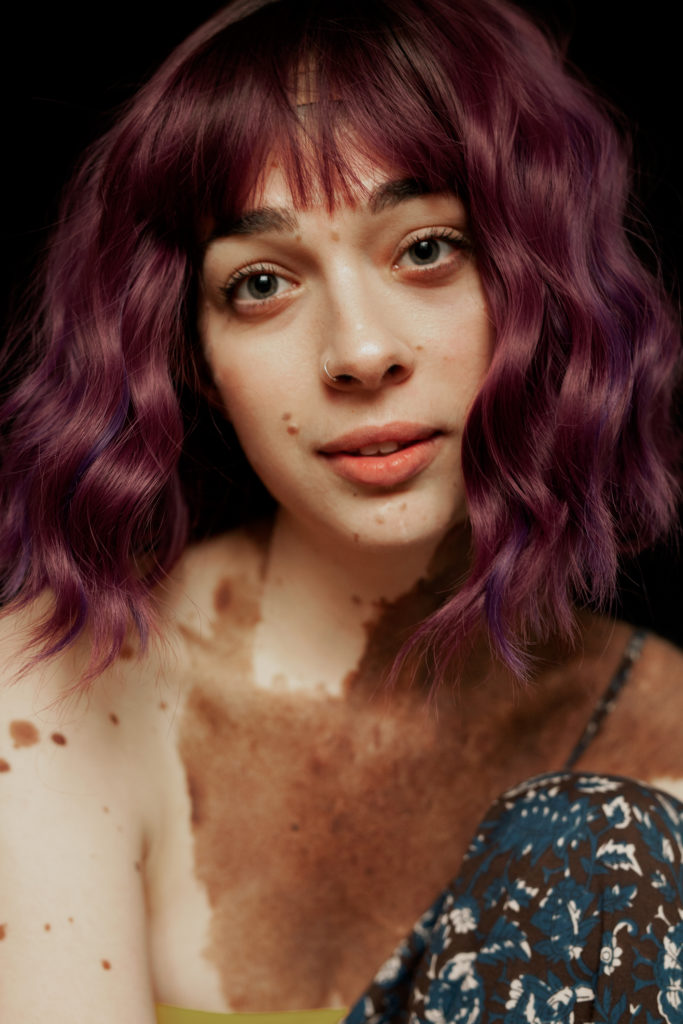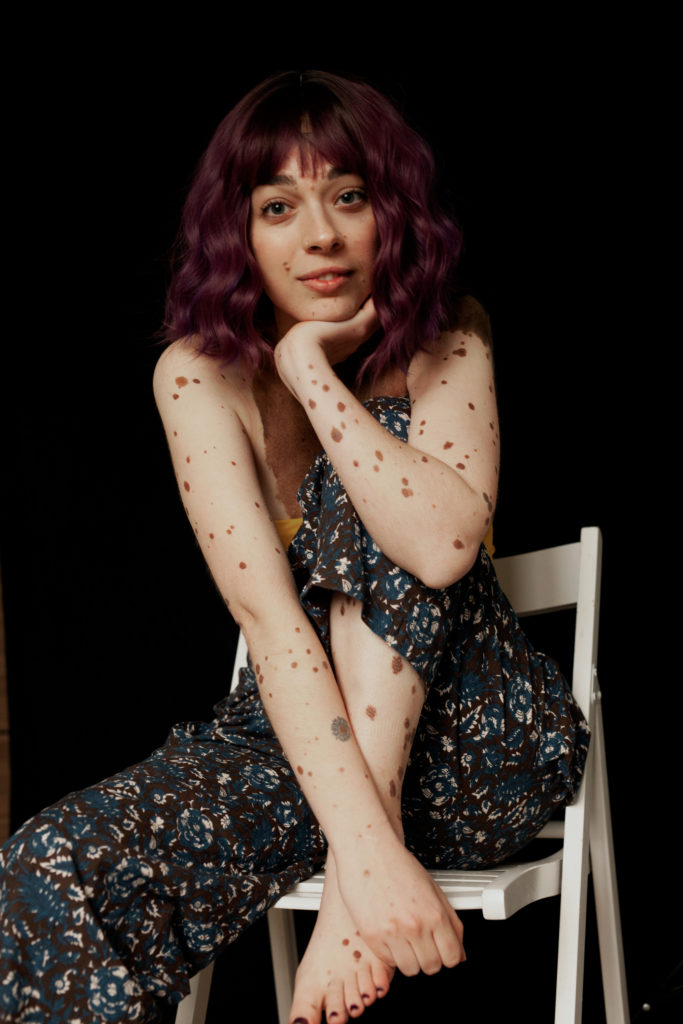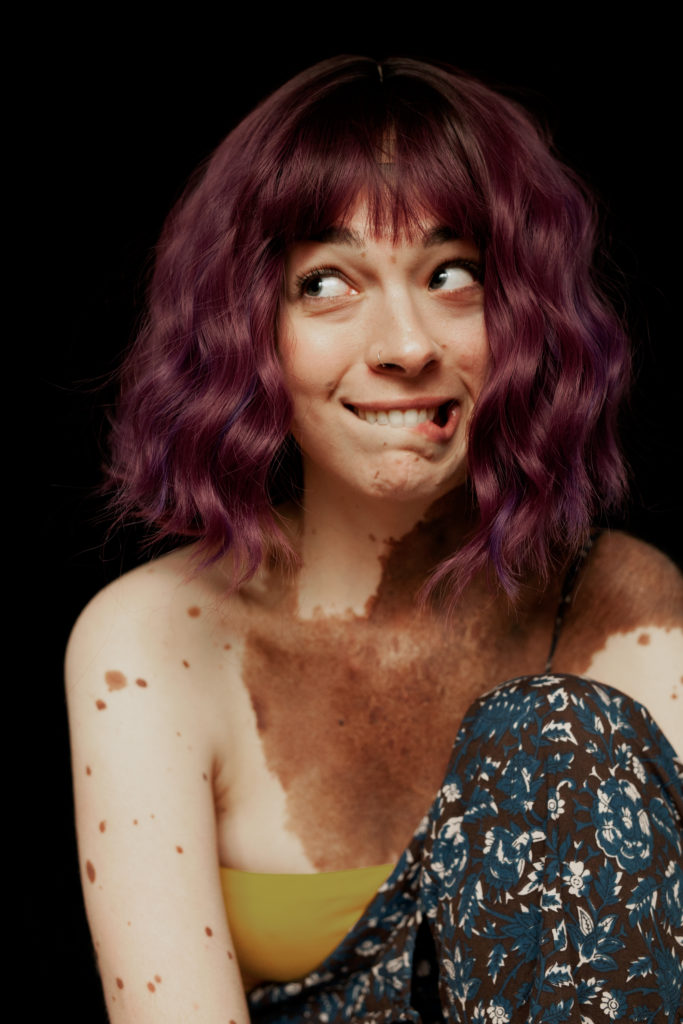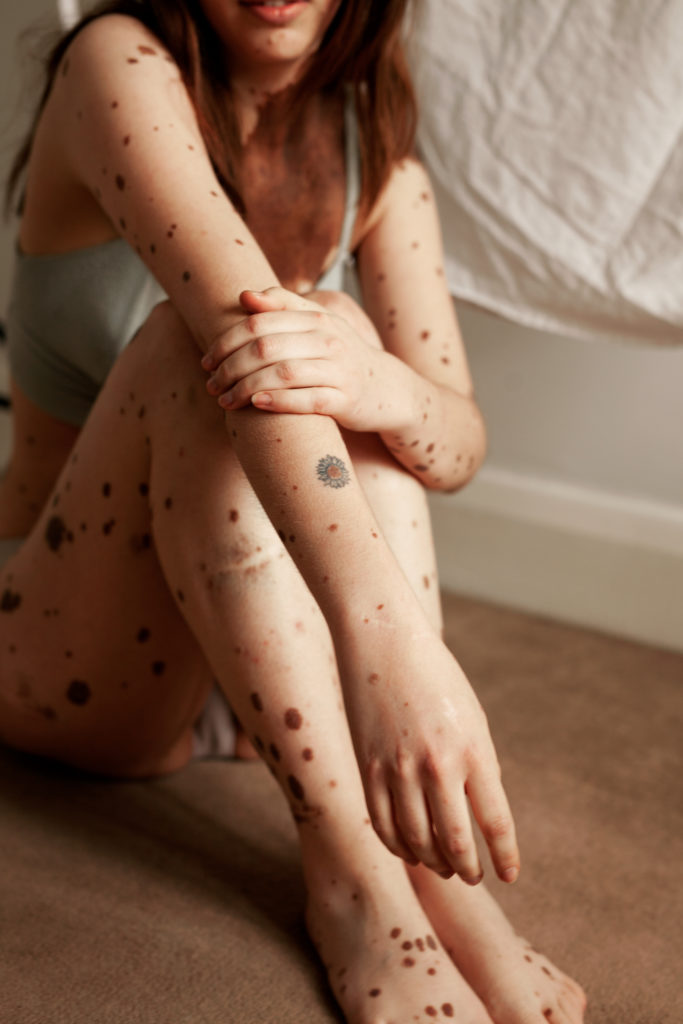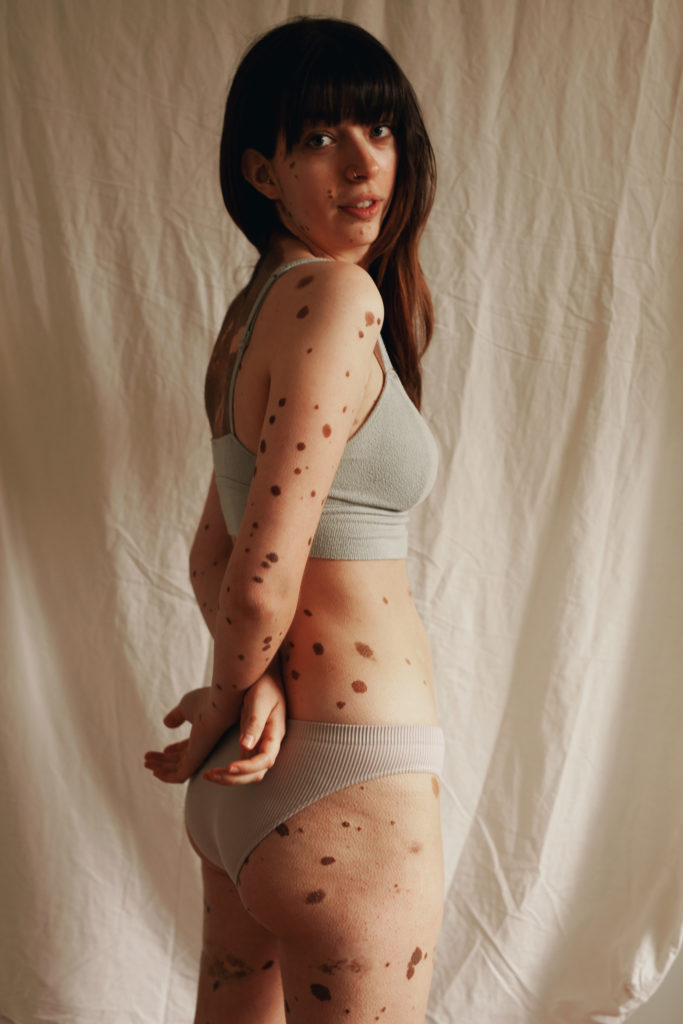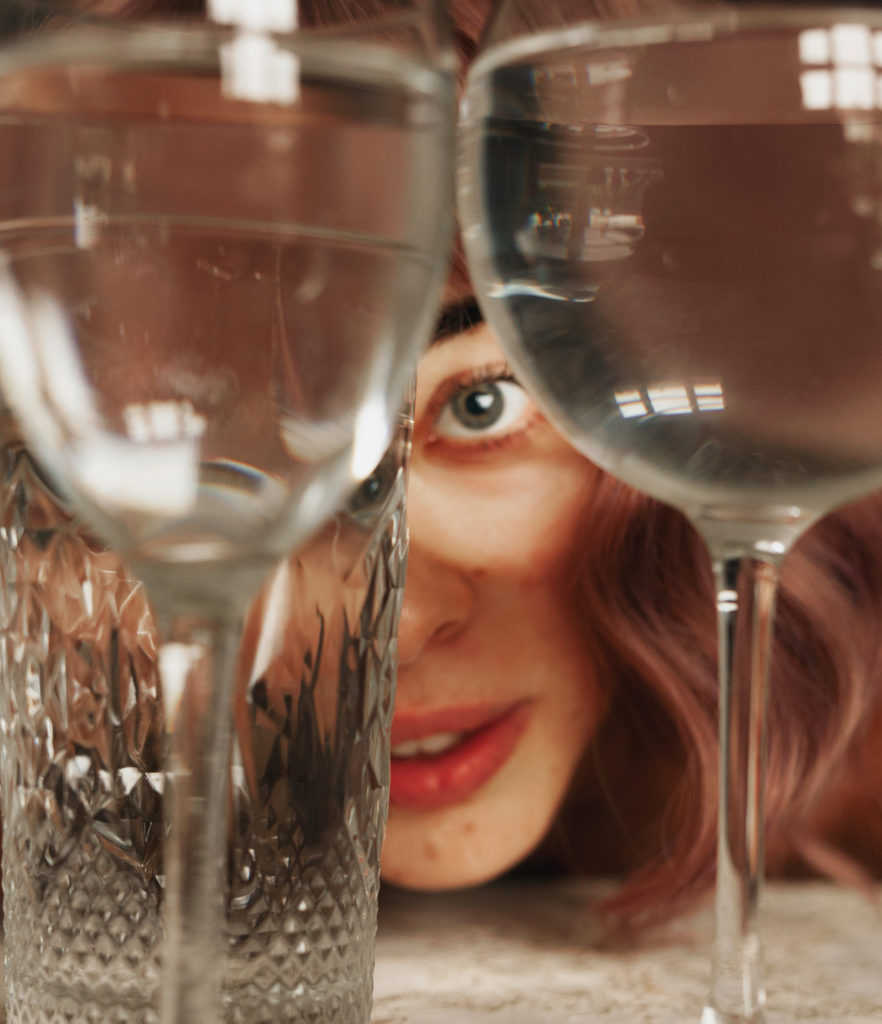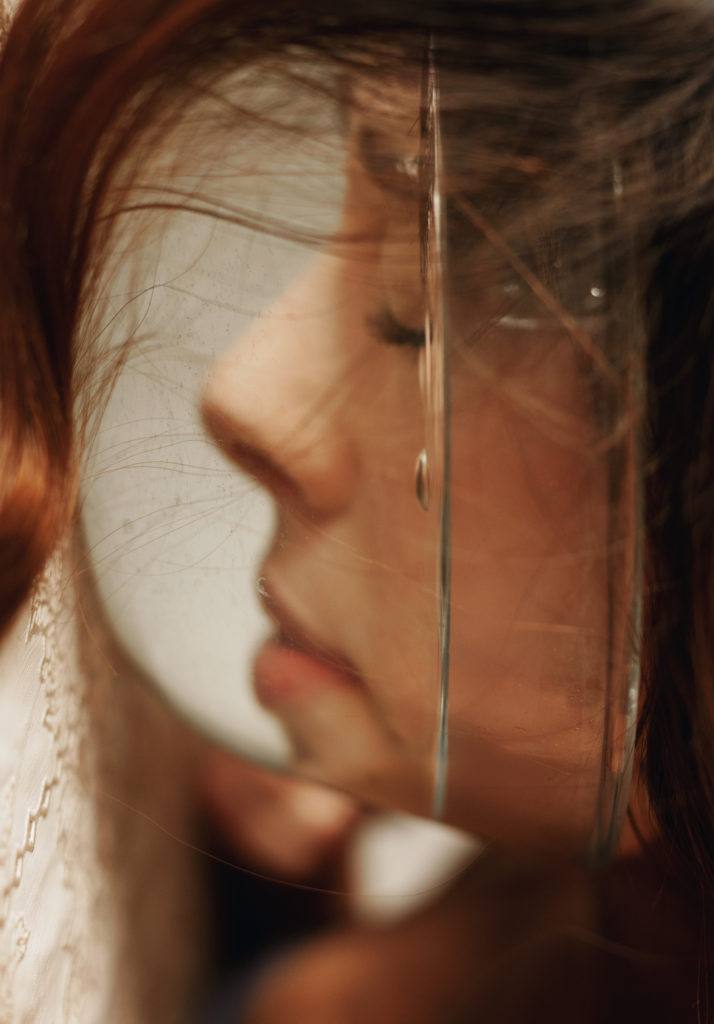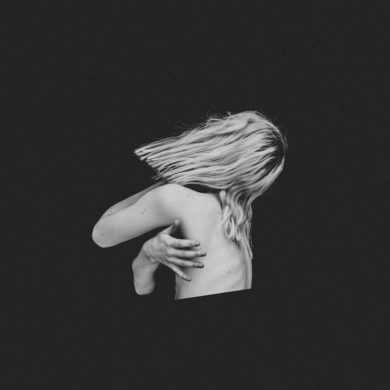Photography & Art direction by Luce Lapadula @lucelapadula
London based 26 year old junior doctor and Model Gemma Whyatt has a rare skin condition called congenital melanocytic naevus (CMN), that less than 1% of the world’s population is born with, manifesting as hundreds of birthmarks all over her body. In this interview Gemma opens up to us in a very free and spiritual way, to help raise awareness on this little-known skin condition, that can affect severely the mental health of people that have it. She teamed up with one of our favourite portrait photographers Luce Lapadula, whose dreamy and intimate imagery is an ode to diversity and a manifestation of female empowerment; from rejecting stereotypes, to enabling change. Together they created a very inspiring, thoughtful and fun series, with the aim to show that everyone is unique and to emphasize the importance of loving yourself the way you are.
Hi Gemma! Can you please introduce yourself?
Hi, of course! I am a 26 year old junior doctor from Cambridge currently living and working in East London. I love my job and in my free time enjoy cooking, the outdoors, trying to keep my houseplants alive and spending time with friends and family (just like everyone else!). I’m a little bit obsessed with dogs and eat way more chocolate than can be good for me. I really love meeting people from different countries and feel most free when travelling. I am passionate about global health and social issues and volunteer with refugees.
You have a rare skin condition called CMN (congenital melanocytic naevus). Can you explain what CMN is?
CMN means, literally, ‘pigmented birthmark present from birth’. Around 1% of people have a single, small CMN while having multiple or much larger CMN is quite rare, between 1 in 20,000 and 1 in 50,000 depending on who you ask. It happens by chance due to a genetic mutation while the baby is forming – the earlier on in development the more extensive the birthmarks. It is not something that can be inherited or passed down. The CMN often have more hair and can be drier or more fragile than surrounding skin. They often fade to varying degrees as the person ages, and often eventually change colour to match complexion/hair colour. In around 20% of people with CMN it can also affect the brain, which may or may not cause problems like epilepsy or developmental problems. This can be detected with an MRI scan. Around 10% of children for whom the CMN affects the brain may go on to develop melanoma (skin cancer). Overall, the risk of melanoma for people with CMN is about 1-2%, only marginally higher than the risk for the rest of the population which is about 0.5%. Surgical treatments do not reduce cancer risk.
CMN is different to vitiligo which is an autoimmune condition that develops later in life. CMN affects people of all genders and ethnicities. How it affects someone varies enormously depending on a variety of factors, and perceived severity of a visual difference does not necessarily correlate at all with a person’s self image or self-esteem. You can read more about CMN at https://www.caringmattersnow.co.uk/about-cmn/
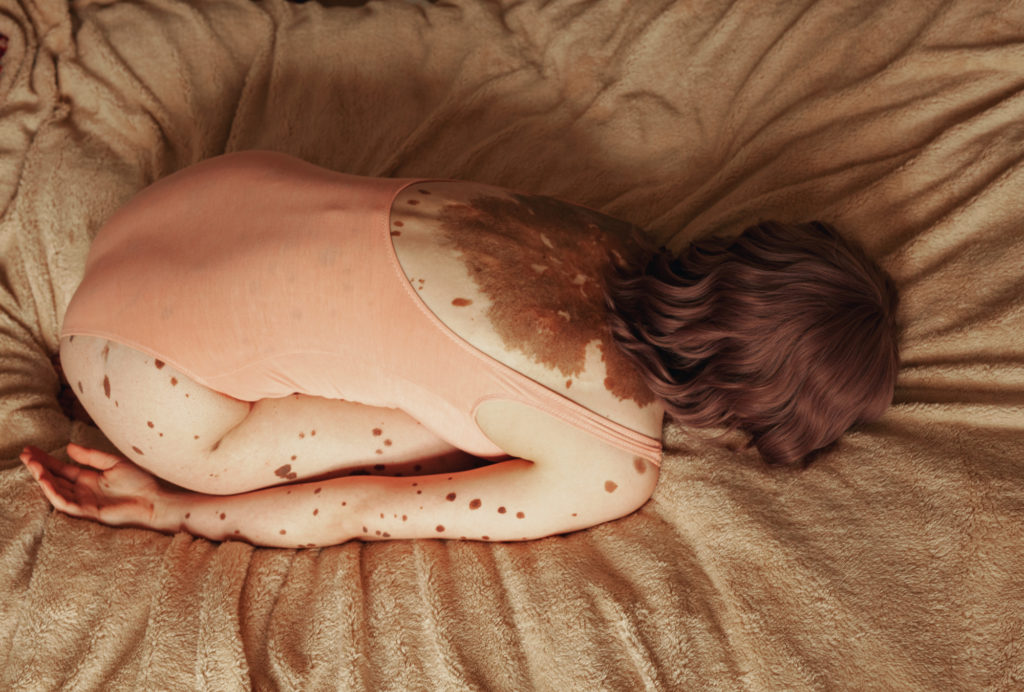
I had over 20 operations of different types as a small child, with a lot of scars and some disfigurement as a result. In a way, I’m glad most of these surgeries weren’t very successful at removing my birthmarks, because I would be a different person without them!
Growing up with CMN, has certainly played a major role in your life. how was it for you? Did you ever feel “othered”?
After I was born, my family was referred to plastic surgeons who decided to gradually try to remove my birthmarks, to ‘improve’ the way I looked – there’s no medical benefit but perhaps in the 90’s society was less accepting of people’s differences and they thought this would be best for me. I had over 20 operations of different types as a small child, with a lot of scars and some disfigurement as a result. In a way, I’m glad most of these surgeries weren’t very successful at removing my birthmarks, because I would be a different person without them! Luckily, I was too young to consciously remember much about that time, but it meant from day one I was already singled out as different, with the inherent message that I needed somehow to change or hide my natural appearance to fit in.
Despite always knowing I was different from the others, and perhaps this is rose-tinted, it didn’t bother me and I integrated pretty well at school. I was on all the sports teams and until mid-secondary school don’t remember thinking about my appearance very much. I think my classmates were all just used to the way I looked and I had good friends. When I did encounter problems or mean comments it usually came from people who didn’t know me – for example playing a sports match at another school. But having talked to my friends since, I realise how protective they were of me, shutting down comments before they could reach me. One friend I confided in about some online bullying from kids from another school even contacted their headteacher who dealt with them without me even realising. That’s pretty impressive behaviour for a 15 year old!
While I remember becoming more consciously aware of my differences when I was a teenager, I did develop body-focused and other mental health problems from an earlier age which I now understand are likely related to trauma relating to my skin condition – I am currently in therapy to work through this.
How would you usually react if people judged you in your teenage years?
Sometimes I would feel very angry and hurt – if someone stared at me maybe I would stare back. Sometimes I would try to cover up – put my jacket back on or undo my hair. My mum encouraged me to try just smiling, showing them that I am okay as I am – it was an effort but I began to find that worked better!
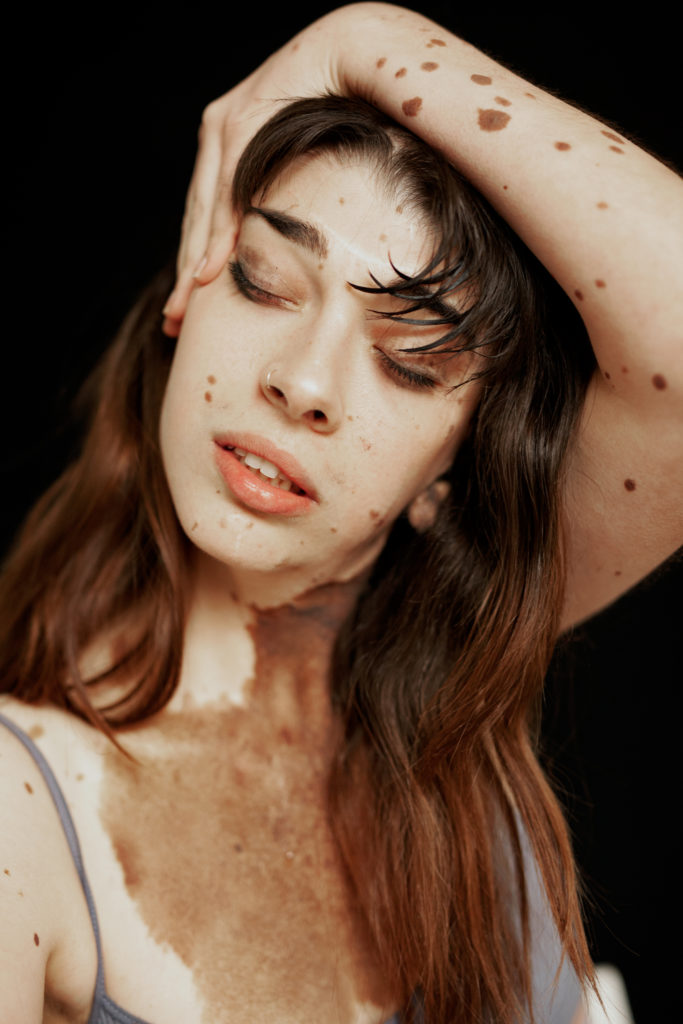
Self-love is not about loving every part of yourself all the time but realising your own self-worth, and understanding that it is not dictated by society or dependent upon the opinions of others.
You are now raising positive awareness of CMN, with a clear message: “Love the skin you’re in embracing your visible difference.” Would you say self-love is the best act of resistance?
Society for so long has been intolerant of differences in many aspects of identity; race, religion, appearance to varying degrees in different contexts. We are very good at making people feel othered for no clear reason. The impression of self-love as an act of resistance comes when more and more people see its effects, having a positive impact on both the individual and a knock on effect to break down barriers. This in turn encourages others to feel more comfortable, gradually reducing the prevalence of discrimination and marginalisation. Self-love is not about loving every part of yourself all the time but realising your own self-worth, and understanding that it is not dictated by society or dependent upon the opinions of others, which of course we have no control over. This is indeed a great act of resistance as gradually we are influencing collective attitudes in this way and promoting a more tolerant and caring society.
What has helped you being more comfortable in your own skin? Any anecdote in particular?
I’d always been quite interested in learning Spanish, and when I was about 16 found some penpals my age in an online forum. We ended up becoming good friends and I spent a lot of my school holidays for the next few years visiting these different friends around Spain. Now of course a big part of spending the summer with friends who live by the sea in a warm country is going to the beach. This was a major source of anxiety to me at the time – I could easily avoid going to the pool or beach back home but not really here. With the support of my friends and their families I gradually stepped out of my comfort zone and started going to the beach in a bikini. I remember one day I saw some local boys I knew doing parkour near where I was laying on my towel and hoped they wouldn’t notice me or come over, but they did. And nothing bad happened! They just greeted me and seemed pleased to see me and have a chat. Nobody drew attention to my birthmarks, and that meant a lot coming from a group of teenage boys I didn’t know that well!
That moment really stands out for me as a turning point, among similar encounters from around that time, and I began to challenge myself with what sorts of clothes and situations I put myself in. Gradually I stopped wearing scarves and long sleeves all the time and realised that actually not only was showing more of my skin more freeing, when people did comment on my newly debuted skin, it was often more positive than negative – ‘wow your marks are so interesting, could you tell me more about them?’. My confidence started to grow which in itself I think perhaps made those who might have made an ignorant comment or judge me, think twice.
I still don’t feel comfortable with how I look all the time – it depends a lot from day to day – but most of those insecurities now come from features other than my birthmarks. My relationship with my skin condition has improved so much over the last 10 years or so, and I put a lot of it down to having incredibly supportive friends and family.
To me, beauty is more about the feeling that something evokes, it doesn’t have to be an object or a person.
What does Beauty mean to you?
To me, beauty is more about the feeling that something evokes, it doesn’t have to be an object or a person. You know that feeling of awe and appreciation you get when you look at a landscape with fresh snow or the moment in a film where long lost lovers reunite? You could describe both as beautiful without really thinking about what you mean by that or why – it’s just a feeling you recognise.
How was it for you posing in front of the camera for the first time?
The first time I modelled for a professional photographer was actually in 2015 I think… I was on holiday with friends in Paris and a French person I didn’t know (who later turned out to be the lovely photographer Delphine Blast) chased me down the street and invited me to model for some portraits at her studio. It was quite a surprise but I agreed and we took some pictures a few days later. I didn’t really know what I was meant to do but she guided my poses and I was honestly stunned at the final results. I think they ended up in a ‘Body’ themed exhibition/soiree. The pictures were not just traditional portraits but high-definition studies of different parts of my body – feet, back, stomach… It was an important moment for me in appreciating that people might find the way I looked interesting for artistic reasons for a change!
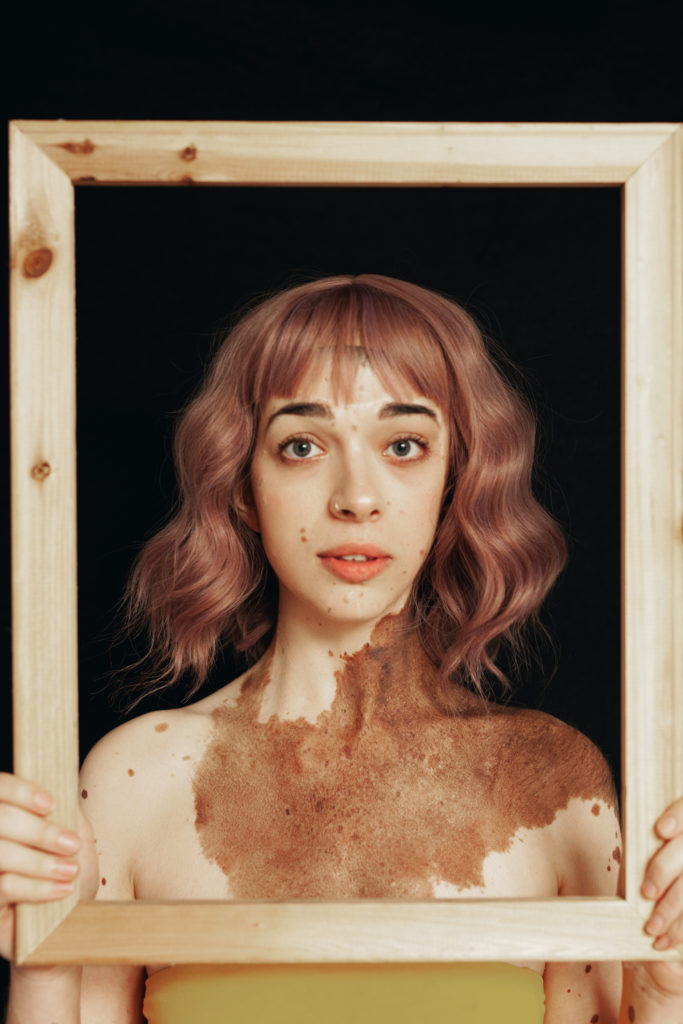
I see so much value in collaborating with photographers, both for my current relationship with my body and for my younger self who never saw people like her represented in art, media or fashion.
A few years ago, you were chosen as the first model of a worldwide exhibition project #howdoyoucmenow by British photographer Brock Elbank & @caringmattersnow, alongside 30 other participants. Tell us about that experience. What was the impact of such exhibition on you and around you? Has meeting other people with similar skin as yours, changed your perspective?
When Jodi (founder of Caring Matters Now) asked me if I would model for some portraits, it was not long after that first experience modelling in Paris. I had quite enjoyed that and was keen on the idea, especially having seen the beautiful images of Alejandra on social media in Brock’s ‘Freckles’ series – she has both freckles and CMN and that’s sort of how the project & collaboration started. Initially we thought maybe my pictures would be submitted to a women’s magazine, but gradually the project gained more interest and grew, until about 3 years later it had evolved into an international exhibition – I hadn’t realised what I’d got myself into!
The 2 weeks that the exhibition was open in London were honestly some of the most transformative of my life. On the one hand I was juggling university with media interviews and responding to the influx of messages from people around the world, on the other I was trying to process the experience of meeting so many other people whose skin looked like mine, most of whom I’d only seen or spoken to before over social media. We did a private launch night with drinks at the gallery for the participants and their guests. It was very emotional and also the first time I had seen most of the portraits – I was fascinated by the unique beauty captured in every single one.
For this @curatedbygirls feature, you were photographed by Luce Lapadula. How was the shoot? Do you find it different being photographed by a woman?
The shoot for this feature was one of the most enjoyable ones I’ve done! Luce was so welcoming and hospitable, and made every effort to make me feel comfortable, both physically and emotionally (thank you for the heater and the pep talk!) She is also a very good chef and we shared some delicious spaghetti with olive oil from her home town. I was impressed with Luce’s connection to her creativity and freedom of expression – I was a little skeptical about putting my face in a bowl of water but the shots turned out fantastic! I’d brought some wigs as props for the shoot and I think we have both decided we want to dye our hair pink now…
I feel like I came away from this photoshoot with Luce with not only some beautiful, fun images, renewed interest in photography and modelling but a new friend.
Whether I find it different being photographed by a woman… I imagine many models probably find it easier to relax and connect more with female photographers, for me especially as a lot of the modelling is about capturing my skin. I wish that there were no difference and I have had some great shoots with male photographers too, but when the subject is female form and intimate portraits, of course it feels different within the societal context of women’s bodies and male vs female gaze.
CMN is still a very little-known skin condition today. Why is it important to raise awareness about it? Do you think social media can be used as a powerful tool to educate people about it?
Social media is probably one of the most powerful tools for raising awareness about anything – it’s where most people get their information from daily and as content can be created and shared by ordinary people, rather than newspaper or magazine editors, there is far more scope for connecting and sharing real lived experiences, images and reaching the millions of people who use social media. The more we can raise awareness about a condition, the more people will recognise and understand it which makes life a lot easier for those living with it!
Beyond educating people about the condition, social media also facilitates online communities – people with visible differences like CMN can connect, feel empowered and supported in a way that might have been challenging before.
It can also reach people all over the world – I have received lots of messages from people from different countries asking questions and sharing their experiences with CMN which has been really heartwarming and meaningful.
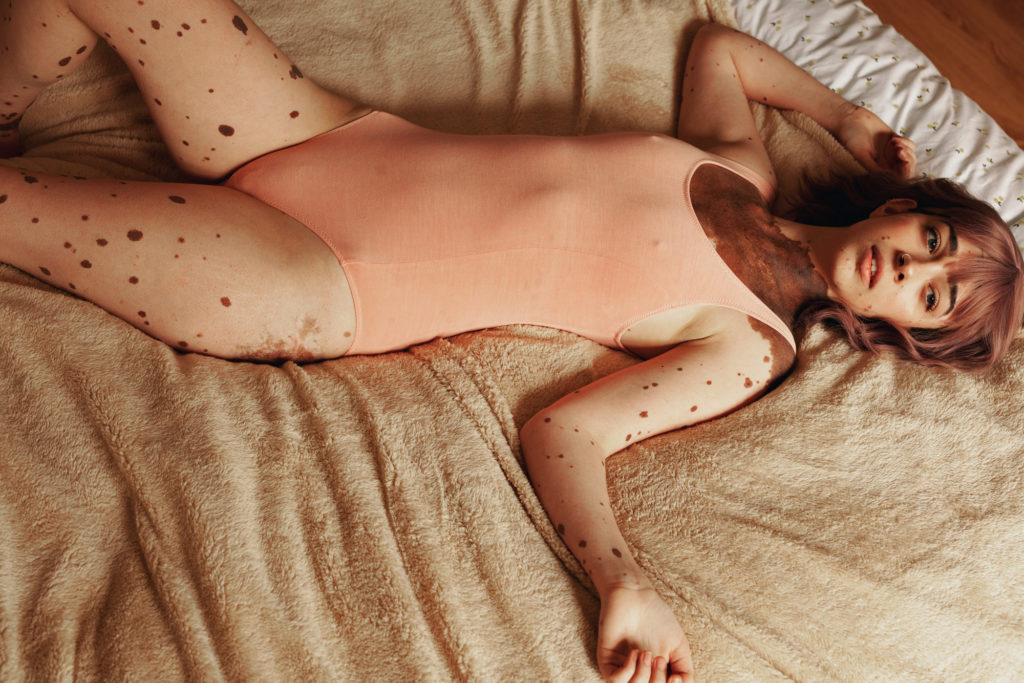
What have you learned about yourself this past year during lockdown?
This has been probably the busiest year of my life so far – I graduated from university early and have been in full time work almost non-stop for over a year now. I’ve moved house 4 times, including to a new city and started my medical career in a pandemic. The year for sure has had its ups and downs for me like many others, but I have learnt that I can cope in situations I never expected to experience and have a lot more confidence in myself, both personally and professionally. I’ve really appreciated having a people-focussed job where I can still go into work and no day is ever the same. I’m getting better at saying no, putting myself first and have learned to appreciate the simple things much more. I’ve also learnt that I can actually keep houseplants alive with a bit of determination!
As the pandemic started, I took the decision to wind down modelling. Not only was it practically difficult and I suddenly became very busy, being fast-tracked out of medical school to the NHS front-line, I was worried about how it might affect my professional reputation. But doctors are humans too. If Dr Alex can go on Love Island and be a national hero, why should I worry about showing my skin? Beyond that, I see so much value in collaborating with photographers, both for my current relationship with my body and for my younger self who never saw people like her represented in art, media or fashion. Sharing images like the ones Luce took will hopefully introduce people to CMN, challenge their perceptions about beauty, diversity, self-image and help to normalise the huge range of visible differences and unique conditions that until recently we so rarely see on our screens or in magazines.
What’s next for you in the pipeline and what do you look forward to?
I’ve got just over a year left of my current job contract before I hope to take a break and go backpacking – travel has always been an important part of my life and I’ve been getting very itchy feet over the past year! I also can’t wait to get to explore more of London when things open up and settle in a bit more here. I’d love to take up some dance classes, go rollerskating with friends and spend more time practicing the guitar. I’m hoping Luce will teach me some more about photography and we can do some more photoshoots! I’ve done some in-person and facetime photoshoots since the shoot with Luce and am looking forward to doing some more over the summer.
Gemma Whyatt: Instagram
Photography & Art direction by Luce Lapadula: Instagram – Website
Pink bodysuit and yellow top from H A R A: instagram


